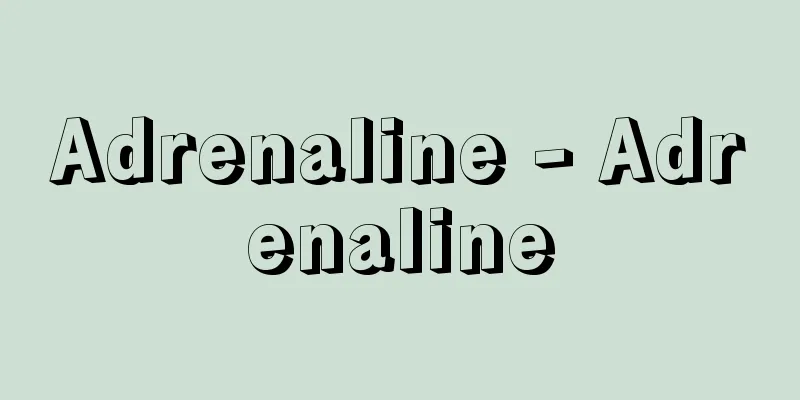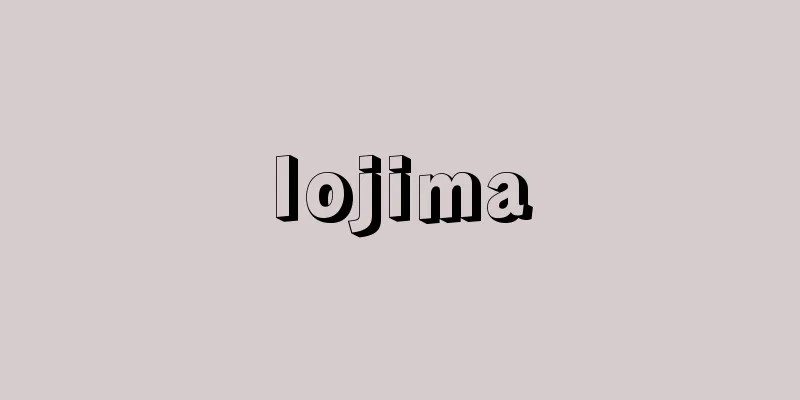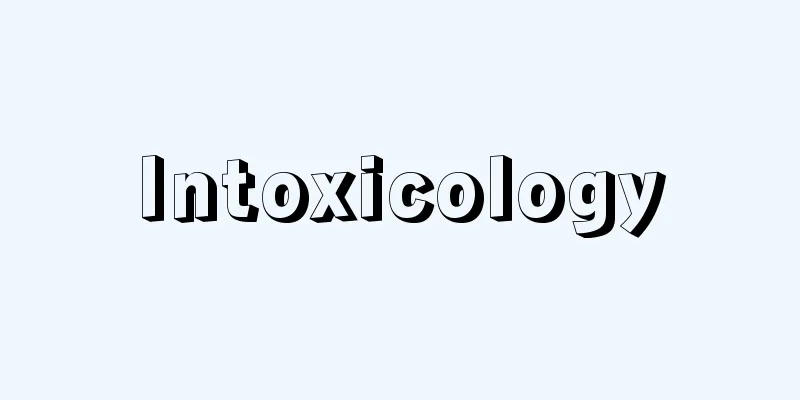Adrenaline - Adrenaline

|
A type of catecholamine (neurotransmitter; a general term for biogenic amines found in the brain, adrenal medulla, and sympathetic nerves) that acts as an adrenal medulla hormone. A basic substance isolated from the adrenal medulla by Jokichi Takamine in 1901 (Meiji 34 ) . Its molecular formula is C9H13O3N , and it was the first hormone to be isolated, purified, and crystallized. It is also called epinephrine, and in medicine it is called epirenamine. The naturally occurring form is the left-handed L-type, which is 15 times more physiologically active than the organically synthesized right-handed D-type. Noradrenaline (norepinephrine) without a methyl group is also secreted from tissues other than the adrenal medulla, but its activity is weaker than that of adrenaline. Both are derivatives of catechol, so they are collectively called catecholamines. Adrenaline is synthesized in the body from tyrosine through dopa (dioxyphenylalanine, DOPA), dopamine, and noradrenaline. It is broken down by amine oxidase after the hydroxyl group is methylated and it loses its physiological activity. Adrenaline contained in tissues other than the adrenal medulla and brain is not synthesized within those tissues, but is mostly absorbed from the blood. In plasma, 70% of adrenaline is conjugated (bound) to sulfate. Sulfate conjugates are inactive and their function is unknown. Adrenaline is a white powder that turns brown when oxidized. Adrenaline secreted from the adrenal medulla enters the bloodstream as a hormone and binds to adrenergic receptors present on the target cell membrane. Meanwhile, adrenaline released from the adrenergic nerve terminal as a neurotransmitter diffuses through the synaptic cleft and binds to adrenergic receptors present on the postsynaptic membrane. Activated receptors induce various physiological responses in the target cell via the intracellular signaling system. There are two types of adrenoceptors, α (alpha) receptors and β (beta) receptors. There are three molecular species of α, α 1 and α 2 , respectively, and β, in addition to β 1 and β 2, also exists as β 3. α 1 receptors are postsynaptic α receptors and exist in effector organs in the periphery. Stimulation of α 1 receptors causes vascular smooth muscle to contract. The α 1 selective antagonist prazosin is used as a drug for treating hypertension. α 2 receptors are located in the presynaptic membrane of adrenergic nerves and prevent the release of noradrenaline from the nerve terminals. β 1 receptors are present in cardiac muscle and fat cell membranes and promote cardiac function and fat breakdown. β 2 receptors are present in the lungs, liver, and smooth muscle, and cause smooth muscle relaxation and glycogen breakdown. β 3 receptors are present in fat cells, cardiac muscle, and vascular smooth muscle, and when stimulated, they induce the activation of lipase, hydrolyzing fat. As a medicine, it is used as a sympathetic stimulant, vasoconstrictor, and blood pressure raiser, to stop bleeding, and to suppress asthma attacks. It is available as an injection, topical, or spray. Overuse can cause side effects such as anxiety, headache, palpitations, and insomnia. [Keiko Koizumi] "New Biochemistry Experiment Course 9: Hormones 2: Non-peptide Hormones," edited by the Japanese Biochemical Society (1992, Tokyo Kagaku Dojin)" ▽ "The Life of Takamine Jokichi: The Truth Behind the Discovery of Adrenaline," written by Iinuma Kazumasa and Kanno Tomio (2000, Asahi Shimbun)" ▽ "Drug Receptors and Diseases: Theory and Practice of Drug Treatment," edited by Miyazaki Mizuo (2002, Iyaku Journal Co.)" ▽ "Simple Pharmacology," edited by Uematsu Toshihiko et al., revised edition (2004, Nanzando)" ▽ "NEW Pharmacology," edited by Tanaka Chikako et al. (2007, Nanzando)" [References] | | | | | | | | | | | | | | | | | | | | | | | |adrenal | | | |©Shogakukan "> Adrenaline Source: Shogakukan Encyclopedia Nipponica About Encyclopedia Nipponica Information | Legend |
|
副腎髄質ホルモン(ふくじんずいしつほるもん)としての作用をもつカテコールアミン(神経伝達物質。脳、副腎髄質および交感神経に存在する生体アミンの総称)の一種。1901年(明治34)に高峰譲吉が副腎髄質adrenal medullaから分離した塩基性物質。分子式はC9H13O3Nで、ホルモンとしては最初に分離精製、結晶化された。エピネフリンepinephrineともよばれ、医薬品ではエピレナミンという。天然に存在するのは左旋性のL型で、有機合成された右旋性D型のものより15倍も生理活性が強い。メチル基のないノルアドレナリン(ノルエピネフリン)は副腎髄質以外の組織からも分泌されるが、その活性はアドレナリンよりも弱い。どちらもカテコールの誘導体であるため、カテコールアミンと総称される。 アドレナリンは生体内でチロシンから、ドーパ(DOPA。ジオキシフェニルアラニン)、ドーパミン、ノルアドレナリンを経て生合成される。分解は、ヒドロキシ基がメチル化され、生理活性を失ってからアミン酸化酵素により行われる。副腎髄質と脳以外の組織に含まれるアドレナリンはその組織中で生合成されたものではなく、ほとんど血中のアドレナリンを取り込んだものである。血漿(けっしょう)中ではアドレナリンの70%は硫酸塩に抱合(結合)している。硫酸抱合体は不活性でそれらの機能はわかっていない。アドレナリンは白色粉末で、酸化されると褐色になる。 副腎髄質から分泌されたアドレナリンはホルモンとして血中に入り、標的細胞膜に存在するアドレナリン受容体に結合する。一方、アドレナリン作用性神経終末から神経伝達物質として遊離されたものはシナプス間隙(かんげき)を拡散して、シナプス後膜に存在するアドレナリン受容体と結合する。活性化された受容体は細胞内情報伝達系を介して、標的細胞にさまざまな生理反応を誘発する。 アドレナリン受容体にはα(アルファ)受容体とβ(ベータ)受容体の2種があり、αにはα1およびα2にそれぞれ3分子種が、βにはβ1、β2に加えてβ3が存在する。α1受容体はシナプス後性α受容体で、末梢では効果器に存在する。α1受容体が刺激されると血管平滑筋が収縮する。α1選択的拮抗薬プラゾシンは高血圧治療薬として使われる。α2受容体はアドレナリン作動性神経のシナプス前膜にあってノルアドレナリンの神経終末からの遊離を阻止する。β1受容体は心筋、脂肪細胞膜に存在し、心機能や脂肪分解を促進する。β2受容体は肺、肝臓、平滑筋に存在し、平滑筋弛緩やグリコーゲンの分解をおこす。β3受容体は脂肪細胞、心筋、血管平滑筋に存在し、刺激によってリパーゼの活性化を誘発し、脂肪を加水分解する。 医薬品としては交感神経興奮剤、血管収縮剤、血圧上昇剤として使われ、出血を止め、気管支喘息(ぜんそく)の発作を抑える。注射剤、塗布剤、スプレー剤などがある。繁用すると、不安、頭痛、心悸亢進(しんきこうしん)、不眠などの副作用が現れる。 [小泉惠子] 『日本生化学会編『新 生化学実験講座9 ホルモン2 非ペプチドホルモン』(1992・東京化学同人)』▽『飯沼和正・菅野富夫著『高峰譲吉の生涯――アドレナリン発見の真実』(2000・朝日新聞社)』▽『宮崎瑞夫編『薬物受容体と疾患――薬物治療の理論と実際』(2002・医薬ジャーナル社)』▽『植松俊彦他編『シンプル薬理学』改訂版(2004・南江堂)』▽『田中千賀子他編『NEW薬理学』(2007・南江堂)』 [参照項目] | | | | | | | | | | | | | | | | | | | | | | | | | | | | | |©Shogakukan"> アドレナリン 出典 小学館 日本大百科全書(ニッポニカ)日本大百科全書(ニッポニカ)について 情報 | 凡例 |
Recommend
Nahr al-'Aşī (English spelling)
… [Kimura Yoshihiro]. … *Some of the terminology ...
Rupicola rupicola (English spelling) Rupicolarupicola
…Several males of the Coting Bird, Perissocephalu...
Indefatigable - Indefatigable
… Twelve gas fields have been discovered in the B...
Diffusion transfer paper
... In color photographic paper (color paper), th...
NGC Catalogue - New General Catalogue of Nebulae and Clusters of Stars
Catalog of nebulae, star clusters, and galaxies. N...
One-to-one mapping
...Therefore, when f ( A ) = B holds, that is, fo...
Arachnida - Arachnida
… Norimitsu Yanagihara writes that “there was a s...
Ashiwada [village] - Ashiwada
A village in Minamitsuru County, southeastern Yama...
Soami
Year of death: 1525 Year of birth: Unknown. A memb...
Gaffel Films
…After the war, he was often rumored to be retiri...
Wahrnehmung
…In ancient Japan, the word “perception” meant “t...
Ramanujan, Srinivasa (Aaiyangar)
Born: December 22, 1887, Erode [Died] April 26, 19...
Knut II - Knut
He was known as Cnut (or Canute) I as King of Engl...
"Wasteland Poetry Collection" - Arachi Shishu
...6 volumes in total. Modernist poets who had ex...
Kamishimo guardian
...Their duties include helping with costume chan...









